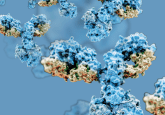LC–MS/MS for quantitation of protein biomarkers
In this podcast, Director of GLP bioanalysis Lan Li reviews mass spectrometry-based methods as tools for protein biomarker quantitation and briefly explores various mass spectrometry approaches, such as top-down, middle-down and bottom-up. Focusing specifically on the bottom-up approach, Lan reviews the general sample preparation procedures required. She concludes by reviewing the current challenges impacting protein biomarker quantification and how QPS Holdings, LLC is developing solutions to overcome them.
About the Speaker:
 Lan Li
Lan Li
Director of GLP Bioanalysis
QPS Holdings, LLC (DE, USA)
Lan Li is Director of GLP Bioanalysis at QPS, LLC. After graduating from Cleveland State University (OH, USA) with a PhD in clinical-bioanalytical chemistry in 2011, she joined QPS, LLC and continued her focus on bioanalytical method development and validation. She is currently leading a team working on LC–MS/MS analysis of biologic molecules, including but not limited to biomarkers (both small and large molecules), peptides, proteins, oligonucleotides, lipids and conjugates.
Podcast transcript
[00:05] Ellen Williams: Hello and welcome to our podcast episode exploring immunoprecipitation liquid chromatography tandem mass spectrometry for quantitation of protein biomarkers. I’m your host, Ellen Williams, and today I’m joined by Lan Li, Director at QPS Holdings, who oversees bioanalytical method development, validation and sample analysis for a variety of molecules, using LC-MS/MS. Thank you very much for joining us, Lan!
[00:30] Lan Li: Yeah my pleasure, thank you for inviting me.
[00:32] Ellen Williams: So please could you start off by telling us a little bit about yourself, your role and the wider team that you work with?
[00:38] Lan Li: Sure. After I graduated from Cleveland State University with a PhD in clinical bioanalytical chemistry in 2011, I joined QPS, LLC and continued my focus on bioanalytical method development and validation. I’m currently leading a team working on the LC–MS/MS analysis of biological molecules, my focus including but not limited to biomarkers (both small molecules and large molecules), peptides, proteins, oligonucleotides, lipids and conjugates.
[01:17] Ellen Williams: Fantastic Lan, thank you. Let’s get straight into our topic for today, which is the quantitation of protein biomarkers, as we’ve mentioned. So if we go from the basics, can you talk us through what biomarkers are and why it’s important to quantify them?
[01:33] Lan Li: Biomarkers are endogenous biological molecules indicating physiological or pathological conditions, vital for disease diagnosis and drug development. A good example would be insulin, which is a small protein hormone naturally produced by the human body for blood sugar regulation. It is crucial in the diagnosis and classification of diabetes. Another example would be AFP (alpha-fetoprotein), which is a protein produced by [the] fetal liver as a carrier protein for fatty acid transportation but can serve as an indicator of liver tumors in adults.
In the pharmaceutical industry, biomarker quantifications are sometimes required to support drug development and regulatory decision-making. For example, cholesterol and its related lipids (LDL, HDL) and ApoB are key biomarkers for cardiovascular disease therapeutics.
Protein biomarkers, with a tighter association with the disease state indication, are often more specific than small molecule biomarkers. However, due to their low endogenous abundance, protein biomarker quantification often adds extremely high requirements to the method’s sensitivity. A good example would be some cytokines, such as Interleukin-6. Its typical blood concentration is only 1 to 5 pg/mL. However, it is strongly associated with inflammation and immune responses and can rise significantly during infections or inflammatory conditions. Quantifying these protein biomarkers, often present in low abundance, requires highly sensitive and specific bioanalytical methods, with mass spectrometry emerging as a key technology alongside immunoassays.
[03:50] Ellen Williams: You mentioned there that people often opt for a mass spectrometry-based technique or will use immunoassays to quantify protein biomarkers. Can you walk us through each of these techniques in a bit more detail?
[04:03] Lan Li: There are two main approaches: immunoassays and mass spectrometry-based methods. Immunoassays, typically including ELISA and protein microarrays, and flow cytometry, are the most widely used approaches due to their high sensitivity and throughput. However, mass spectrometry-based methods have gained increasing interest through their high specificity and improving sensitivity. More importantly, mass spectrometry-based methods can provide information that the traditional immunoassays may not be able to elucidate, such as post-translational modifications (PTMs) or single-point mutations.
The typical detection limit of a standard sandwich ELISA is in the 10-100 pg/mL range. The mass spectrometry assays used to only be able to achieve low nanogram per mL range, now can also reach 100 pg/mL range or lower. An article published in July 2025 in the Journal of Molecular Genetics and Metabolism reported a mass spectrometry-based method that could reliably detect ubiquitin protein ligase E3A, a protein of around 98 kDa, from CSF samples at 2.5 pg/mL. The much-improved sensitivity is mostly realized by improving signal-to-noise ratio of new generation mass spectrometers, application of micro-flow or nano-flow liquid chromatography, and analyte enrichment via immunocapture. For example, one of our protein biomarker assays can reach a limit of quantification of 150 pg/mL for a protein of ~15 kDa by utilizing micro LC coupled with the newest generation of mass spectrometers. As there was no suitable capture antibody to concentrate the analyte from the matrix, we used solid phase extraction post-digestion to concentrate the signature peptide from the digestion product. Although this is not the ideal methodology, it still provided insight that mass spectrometry-based methods are catching up with respect to sensitivity.
[06:49] Ellen Williams: If we look solely at mass spectrometry-based methods, how are people approaching these methods? Is there a preferred way of doing them?
[06:57] Lan Li: When it comes to the mass spectrometry analysis of proteins, there are three most common ways: top-down, middle-down, and bottom-up. Top-down mass spectrometry analyzes intact proteins and provides information on proteoforms and complex modifications. Top-down can concurrently elucidate PTMs, differentiate proteoforms, and may offer a glimpse of the protein’s functional state as a whole, rather than in multiple different peptides.
Middle-down mass spectrometry analyzes partially digested proteins, often requires closely controlled digestion conditions, and can be challenging [with] getting reproducible data in quantitative analysis. This approach is also known as ‘subunit analysis’ for the higher molecular weight proteins that are difficult for top-down and bottom-up methods.
Bottom-up mass spectrometry analyzes the smaller peptide fragments from fully digested proteins. As the bottom-up analysis relies heavily on the specificity of the signature peptides, signature peptide selection would be essential for the successfulness of a protein biomarker quantification. This is especially true when it comes to the analysis of a protein biomarker that has several proteoforms. It will be important to identify the regions that are unique to each of the proteoforms and select proper protease to release these signature peptides for analysis. For example, human mature frataxin and its extra-mitochondrial isoform, frataxin E, only differ by a few amino acid residues at the N-terminal, where frataxin E carries five more residues and a N-terminal acetylation. Therefore, while selecting signature peptides for the quantification of each protein, this region would be the only choice.
[09:17] Ellen Williams: What are the typical sample process procedures for using a bottom-up approach for protein biomarkers?
[09:24] Lan Li: The sample processing procedure can vary from the simplest, such as digest-and-inject, to the most complicated, such as immunoprecipitation, enzyme digestion, followed by solid phase extraction. It really depends on the target assay ranges and the level of interference or baselines. However, when it comes to protein biomarkers, it is essential to ensure assay specificity, as it is very challenging to obtain authentic blank matrix to serve as the control.
In theory, it is possible to digest the protein of interest in the matrix, followed by LC–MS/MS quantitation. Although LC separation combined with MRM can, to a great extent, provide highly selective detection for the target signature peptide. Considering the complexity of biological matrices, it is still conceivable to have false positives from endogenous peptides or other molecules with similar retention time and MRM transitions. High-resolution mass spectrometry methods may better exclude unrelated molecules that happen to have the same retention time, but are often not as sensitive as triple quadrupole mass spectrometers.
On the other hand, immunoprecipitation, due to its highly selective interaction between the capture antibody and the target protein, adds another layer of assurance for assay specificity. The method typically immobilizes the capture antibodies on magnetic beads. By incubating the capture antibody-coated magnetic beads with the biological samples, the target protein can be trapped by the beads and eventually get “fished out” with the beads. This process is especially efficient in concentrating the target protein analyte from a bulk aliquot of biological matrix to reduce matrix effect, and therefore, can also greatly help in improving the analysis sensitivity.
[11:49] Ellen Williams: You mentioned previously the need for high specificity and sensitivity in these methods, but are there any other major challenges people should expect to encounter when performing protein biomarker quantification?
[12:02] Lan Li: The first challenge of protein biomarker analysis is sample collection and preparation. Blood-based sampling is certainly easier to achieve and allows repetitive sampling in most types of test subjects. However, it may fail when measuring tissue-specific proteins. Let’s use frataxin as an example again. Although it is widely expressed in all cells, only certain tissues, such as heart, spinal cord and brain, will show significant level changes during the disease state, and therefore, it is only meaningful to analyze tissue concentrations.
The second challenge is obtaining suitable reference standards. Since it is impractical or inefficient to purify the target proteins from bio-matrices, recombinant proteins are often used. In other words, these proteins may not represent the naturally presented biomarkers sufficiently while serving as the reference standard. Some proteins expressed in E. coli may miss important PTMs and some of these modifications may be unique to a certain disease state. For example, α-Synuclein aggregation and fibrillization have been suspected as triggers of Parkinson’s disease. The cause of this aggregation, in addition to the elevated level of α-Synuclein, may also be associated with its PTMs. Therefore, synthesizing α-Synuclein with desired PTMs would be critical to the analysis. If the protein biomarker is a membrane protein, the solubility of the protein may be an issue to be addressed. Detergent may need to be added to increase the protein’s solubility. In some cases, specific lipids may need to be introduced to interact with the protein and hence improve its solubility.
The third challenge is selecting proper surrogate matrices. As mentioned previously, it is unlikely to find true authentic blank matrices for biomarker assays. Therefore, a suitable matrix or a surrogate matrix is typically used to construct the calibration curve. To avoid biased analysis caused by the matrix effect difference between the authentic matrix and the surrogate matrix, the equivalency and parallelism between the two matrices need to be carefully studied during the method development and properly demonstrated during method qualification or validation.
The above challenges are associated with the overall experimental design for protein biomarker analysis. There are more challenges that are generally associated with the analysis procedures, such as non-specific binding, chemical stability, storage stability, capture reagent performance consistency, digestion efficiency consistency, recovery, etc. To overcome these issues, one of the most effective ways is to use a stable isotope-labeled protein as the internal standard and add it in to the samples as early as possible. This will help to normalize analyte signal loss due to non-specific binding and degradation. More importantly, the stable isotope-labeled protein internal standard can potentially compete with the analyte on the non-specific binding sites on the containers and minimize loss of analyte signals. Of course, this does require high isotope purity of the labeled protein. In fact, while most of the protein PK assays use stable isotope-labeled surrogate peptides to serve as the internal standards, and are only able to set the acceptance criteria as 20% at the non-LLOQ levels and 25% at the LLOQ level. In contrast, validated protein assays utilizing stable isotope-labeled protein internal standard have proven to be successful to improve the assay accuracy and precision to single-digit percentage.
[17:10] Ellen Williams: And to finish up Lan, how would the team at QPS overcome some of these challenges?
[17:15] Lan Li: Well first, we continue to develop clinically relevant biomarkers as our own non-proprietary assays. This means we continue to collaborate with academic research groups that have deep-rooted history in the specific disease states and significant experience in bioanalysis. This ensures we are working on the appropriate biomarkers within the context of use and all the necessary caveats from sample collection to analysis procedures to germane acceptance criteria. We have been hiring more research scientists with backgrounds in biomarker bioanalysis and biochemistry to balance out our traditional hiring of chemists, bioanalysts and mass spectrometrists.
Second, as it has been demonstrated that stable isotope-labeled protein internal standards is important, we have been working with collaborators to generate the clone and the downstream heavy label proteins either in cell cultures or in whole animals. We are planning to set up [an] in-house bioreactor lab to ensure we are providing the appropriate stable isotope-labelled protein internal standards. In this vein, some of our recently hired research scientists have background in molecular biology, cloning, protein expression and PTM mapping.
Last yet not the least, we are developing closer collaboration with instrument companies that have interest in disease markers for non-commercial reasons. The collaboration includes testing out new applications in chromatography, e.g., supercritical fluid chromatography, micro flow instead of standard flow; new ionization source design; new generation of mass spectrometers, and new software. This collaboration ranges from testing at the vendor sites as well as on-site consignment loans to test [for] robustness.
[19:50] Ellen Williams: Thank you very much, Lan, for your time today. It’s been really great to talk with you.
[19:54] Lan Li: Thank you!
[19:56] Ellen Williams: As always, you can find our entire podcast collection on Bioanalysis Zone, under Multimedia. Thank you to everyone who listened in, and thank you again for your time Lan.
Disclaimer: The opinions expressed in this interview are those of the author and do not necessarily reflect the views of Bioanalysis Zone or Taylor & Francis Group.
In association with:








